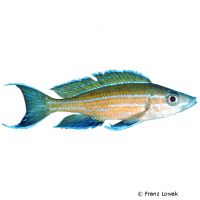Blue Neon Cichlid Chituta (Paracyprichromis nigripinnis 'Chituta')
| Blue Neon Cichlid Chituta Paracyprichromis nigripinnis 'Chituta' | |
|---|---|
| Name | Blue Neon Cichlid Chituta |
| Name Lat. | Paracyprichromis nigripinnis 'Chituta' |
| Family | Cichlids |
| Family lat. | Cichlidae |
| Order | Cichlids |
| Order lat. | Cichliformes |
| Origin | Lake Tanganyika |
| Habitat | Rocky habitat |
| Diet | Carnivore |
| pH | 7.5-9.0 |
| Behavior | Peaceful |
| Keeping | Group |
| Care Level | Moderate |
| Reproduction | Mouthbrooder |
| Breeding | Moderately difficult |
| Life Span | 5-8 years |
| Protection | No |
| Metric Units | |
| Size | 11 cm |
| Temperature | 24-28 °C |
| Hardness | 15-18 °dH |
| Aquarium | 200 l |
| US Units | |
| Size | 4.3" |
| Temperature | 75-82 °F |
| Hardness | 267-320 ppm |
| Aquarium | 50 gal |
Distribution and habitat
The neon carping cichlids Chituta are a site variant of Paracyprichromis nigripinnis that occurs exclusively (endemically) in southern Lake Tanganyika. They are site-faithful schooling fish that prefer to live in large caves of steep rock faces.
Maintenance
The aquarium setup should have rock structures reaching to the water surface on the back wall, with plenty of hiding places (caves, crevices, shelters) and provide subdued light and plenty of swimming space.
No ammonia, ammonium and nitrite should be detectable, the nitrate value should not exceed 100 mg/l. To ensure the water quality and oxygen content, a filter and heater adapted to the aquarium size is required, as well as lighting for the species-appropriate day-night rhythm of the animals.
Diet
In nature they feed on zoo and phytoplankton. The food supply consists mainly of small live or frozen food, such as cyclops, daphnia, artemia and black mosquito larvae or a commercially available frozen special food mixture for plankton eaters, supplemented with high-quality dry food for cichlids (granules, pellets), which is usually well accepted after acclimation. Preserved plankton is also very readily accepted
Only as much should be fed as is eaten immediately (in a maximum of 10 minutes). A regular and varied diet promotes health and increases resistance.
Behaviour and compatibility
It is recommended to keep these swimming fish in a group of at least 7-10 animals, whereby the number of females should predominate. During the breeding season the males behave territorial and defend their territory. Socialization with other Lake Tanganyika cichlids, except cave breeders, is well possible
Basically, only compatible fish species with similar demands on water condition and water temperature should be socialized.
Sex dimorphism
Males are larger and more colorful than females and have extended dorsal and caudal fins.
Reproduction and breeding
They are substrate spawners and maternal mouth brooders. The female spawns upside down close to the rock wall and picks up the sinking eggs (5-25 pieces) individually, after they have been fertilized by the male, for mouth brood care in the throat sac. After about 3-4 weeks, the fry leave the female's mouth and brood care ends
Fry must be fed several times a day with special rearing food (Artemia nauplii, geopods). In community tanks breeding is hardly possible, because the fry are easy prey.
Important
Different site varieties of neon carping cichlids should not be maintained together, as they may interbreed
The aquarium should have a good cover, as they can be very skittish and jump out of the aquarium.
The well-being of the fish should be checked regularly. Temperature should be checked daily, pH, hardness and nitrate levels at least every 14 days. Regular partial water changes are recommended, even if the contaminant level has not yet reached the upper limit. Sudden changes in water quality should be avoided. Newly introduced fish must be accustomed slowly to the water in the aquarium.
Further literature can be found in your pet store.
References
Text: Werner Winter; Image: Franz Lowak
Source: BMELV (1998): Tierschutzgutachten - Haltung von Zierfischen (Süßwasser); BAENSCH & RIEHL (2004): Aquarien Atlas Bd. 2, Mergus Verlag; ENGELMANN (2005): Zootierhaltung - Tiere in menschlicher Obhut: Fische, Verlag Harri Deutsch
- Gemäß § 21 Abs. 5 Tierschutzgesetz idgF
